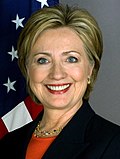Campaign
New York Republicans originally had high hopes of mounting a serious challenge to Clinton, and derailing her expected future presidential bid. [9] However, Clinton was politically strong in the state and no major Republican entered the race, with Governor George Pataki and early 2000 senate opponent Rudy Giuliani both declining to run. [9] The two most prominent Republicans contemplating a challenge to Clinton were lawyer Ed Cox (the son-in-law of former President Richard M. Nixon) and Westchester County District Attorney Jeanine Pirro.
Pirro was considered the front-runner, but her campaign had immediate difficulties. During her August 10, 2005 live televised candidacy announcement in New York City, she paused for more than thirty seconds looking for a missing part of her speech, then asked, on the air, "Do I have page 10?" [9] [10] Democrats re-aired the sequence as part of a Jeopardy! theme parody. [9] The Conservative Party of New York was also reluctant to embrace Pirro. [10] On August 18, 2005, another Republican candidate, former mayor of Yonkers John Spencer, gave a radio interview in which he attacked Pirro, calling her chances of winning the Conservative Party of New York State nomination "a Chinaman's chance." Spencer later apologized. [11]
On October 14, 2005, Governor Pataki endorsed Pirro. Later that day, Cox withdrew from the race; his campaign had raised only $114,249 in contributions in the prior three months. [12] On October 18, 2005, remarks by Pirro that appeared to suggest that Democrats were indifferent to child molesters and murderers drew sharp criticism from the Clinton campaign and others. [13]
Pirro trailed Clinton badly in fund-raising and in polls; her campaign had failed to gain traction. [10] Under pressure from state party officials, she dropped out of the race on December 21, 2005, to run for New York State Attorney General instead, leaving the Republicans without a well-known candidate. [10] [14] The announcement was timed to coincide with the 2005 New York City transit strike, so as to draw minimal attention to the Republicans' difficulties. [10] Pirro did not mention her campaign woes, but instead said, "I have concluded that my head and my heart remain in law enforcement, and that my public service should continue to be in that arena." [10]
Declared Republican candidates now included Spencer and K. T. McFarland, who was a Deputy Assistant Secretary of Defense for Public Affairs under President Ronald Reagan. [15] Cox considered reentering the race but did not. Politically, Spencer was generally opposed to abortion, against gun control, and a supporter of tighter border security. [16] He supported the George W. Bush administration and its policies, including the war in Iraq. Spencer came out in favor of New York's Court of Appeals denying same-sex marriage to 42 gay and lesbian couples who challenged that denial as unconstitutional. Spencer said that marriage equality for same-sex couples equated to "special rights for gays." Spencer was endorsed by Republican officials such as Congressman Vito Fossella. In contrast, McFarland was pro-choice. [9] However, McFarland ran into trouble with a March comment that appeared to allege that the Clinton campaign had been flying helicopters low over her Southampton, New York house and spying on her; she later said she had been joking, but the episode upset her. [9] In May, McFarland's campaign manager Ed Rollins made personal life charges against Spencer, to which the latter responded, "Shame on you." [9]
On May 31, 2006, Spencer won the endorsement of the state Republican Party organization but did not achieve the threshold of 75 percent he needed to prevent McFarland from gaining an automatic position on the primary ballot. He received 63 percent and would thus have to face McFarland in the September 12 Republican primary. Spencer called on McFarland to step aside after the vote, but McFarland said she would not. [17] In a June 2006 radio ad, Spencer attacked national Republicans for not funding his campaign. On August 22, McFarland announced that she would be suspending her campaign until further notice after her daughter was caught shoplifting. [18]








